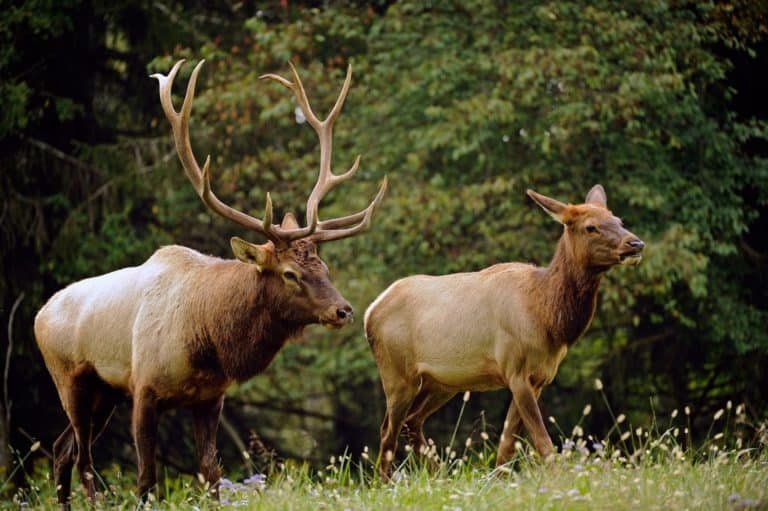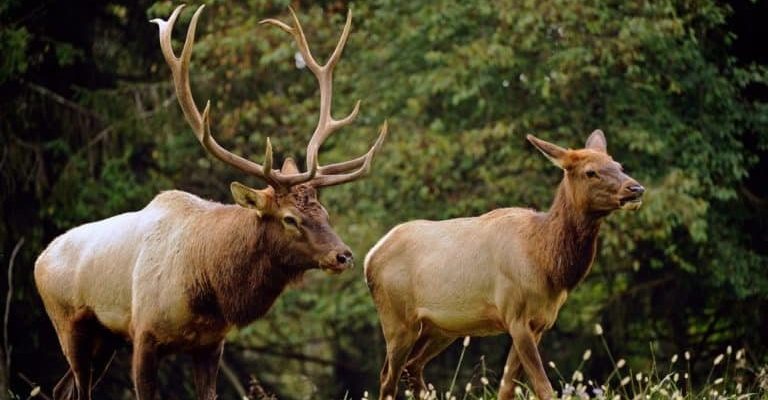
Elk, often found in North America’s forests and grasslands, are fascinating creatures. Their diets are diverse, and how they hunt for food reflects their adaptability and survival skills. Let’s dive into both their eating habits and the strategies they use to sustain themselves in the wild.
Understanding Elk Diet
Elk are herbivores, meaning they primarily eat plants. However, their diet isn’t as simple as munching on grass all day. Elk are selective eaters and can adjust their meals depending on the season and available resources. In spring and summer, they favor tender, nutrient-rich plants. Think of it like picking the freshest fruits and veggies at the local market. They’ll munch on various grasses, leaves, and even young shoots.
In the fall, as they prepare for winter, their diet shifts. They start to consume more fibrous plant materials, including bark and twigs. During this time, the nutritional content of their food can drop, so elk have to be strategic. You might even say they become the ultimate foragers, knowing exactly where to find the juiciest bites.
It’s also worth noting that elk are known to graze in large groups. This behavior helps them find food more efficiently and offers protection from predators. Imagine a potluck where every guest brings a dish; the more, the merrier, right? For elk, having friends around means a better chance of survival.
Seasonal Diet Changes
Just like us, elk adapt their eating habits with the changing seasons. During the warmer months, their meals are like a colorful salad bowl filled with greens. They feast on grasses, wildflowers, and shrubs. These options are not only delicious but also provide essential nutrients to fuel their activities, from roaming vast landscapes to engaging in their famous rutting season.
As the leaves fall and winter approaches, their options dwindle. Elk become more resourceful, shifting to bark and dried grasses. It’s almost like transitioning from a fresh salad to a hearty stew—still nutritious but requiring a little more effort to prepare. In deep snow, they can also dig through the frost to reach buried grasses, showcasing their remarkable adaptability.
Interestingly, the availability of food during these seasonal changes affects their breeding behavior too. Elk tend to gather in larger groups during the rut, which usually happens in the fall. This social feeding not only helps them find food but also strengthens their bonds, making them feel more secure as they face the colder months ahead.
Hunting Strategies of the Elk
Elk might be prey for various predators, including wolves, bears, and mountain lions, but don’t count them out when talking about survival. They employ several strategies to protect themselves while hunting for food. For starters, their keen sense of smell and sight plays a crucial role. Elk have large, expressive nostrils and large, expressive eyes that help them detect danger much earlier than most predators would like.
Elk also utilize their incredible speed. When startled, they can sprint at impressive speeds of up to 40 miles per hour. Imagine a game of tag where you’re the fastest runner—elk are masters at avoiding capture when they need to. They’ll take off in a zig-zag pattern to dodge predators, making it harder for hunters to pin them down.
Additionally, elk often choose to graze in open areas where they can keep an eye out for danger. This is like choosing to sit near the exit at a crowded restaurant so you can see everything happening around you. It allows them to enjoy their meals while staying alert and safe.
The Role of Social Structure
Elk are highly social animals, and this social structure can enhance their hunting strategies. When foraging in groups, they create a sense of safety. There’s strength in numbers, right? The more elk in a group, the more eyes there are to watch for potential threats. Older, more experienced elk often lead the herds, guiding younger members to the best grazing spots.
In addition to safety, social interactions play a big part in their feeding habits. Elk will often engage in playful behavior and vocalizations, such as bugling, which can help strengthen their bonds. These interactions can bring the herd together, allowing for more effective hunting and foraging.
Here’s a fun fact: when elk are rutting, males often showcase their strength through displays of dominance. It’s not just about competing for mates; it’s also about establishing hierarchy within the group, which can ultimately affect their access to the prime grazing locations.
Elk and Their Environment
Elk are not just passive residents of their habitats; they actively shape them too. Their grazing can influence plant growth and biodiversity in their ecosystems. By eating certain plants, they can help prevent overgrowth and promote a healthy balance in their environment. It’s like a natural lawnmower, keeping their home fresh and vibrant.
However, this relationship can be a double-edged sword. Overgrazing in certain areas can lead to habitat degradation, making it more challenging for elk to find food. This is why it’s crucial for communities and conservationists to manage elk populations and their habitats wisely. It’s about maintaining that balance—after all, a healthy environment means healthy elk.
Let’s not forget, elk are also a vital food source for other wildlife. When they are present in an ecosystem, they help support the entire food web. As they roam, they leave behind droppings that fertilize the soil, contributing to the overall health of the ecosystem. This interconnectedness is a beautiful aspect of nature.
The world of elk is rich and intricate, filled with fascinating details about their diet and hunting strategies. From being selective eaters to adapting to seasonal changes, elk demonstrate incredible survival skills. Their social structure and keen awareness contribute significantly to their ability to thrive in various environments.
Understanding these animals not only deepens our appreciation for them but also emphasizes the importance of preserving their habitats. By taking care of the ecosystems where elk live, we help ensure that these magnificent creatures continue to roam our wild landscapes for generations to come. So, the next time you think of an elk, remember that there’s a whole lot more going on than meets the eye—and that’s what makes them truly remarkable.

